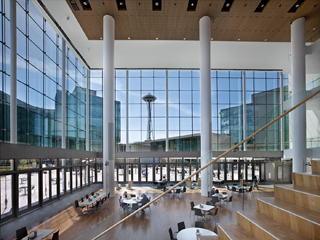|
Subscribe / Renew |
|
|
Contact Us |
|
| ► Subscribe to our Free Weekly Newsletter | |
| home | Welcome, sign in or click here to subscribe. | login |
Real Estate
| |
 |
May 12, 2011
Creating a place to solve the world’s challenges
NBBJ

McConnell
|
The opening of the Bill & Melinda Gates Foundation campus in Seattle represents both a moment in time and history in the making.
The campus is part of Seattle’s growing hub for innovation in global health and development. It will be a place where U.S. education leaders and global experts convene, and it is designed to enrich Seattle’s urban fabric for a century or more.
For the many architects and project partners who have helped bring the campus to life, it represents a project of a lifetime. For the staff and partners of the Gates Foundation, the new campus is a global center where they can work, learn and solve problems.
Co-chair Melinda Gates identifies the heart of the project when she says, “Our new location will give our staff and partners a place to do their best work — with the ultimate goal of giving all people a chance to live a healthy and productive life.”
As you can imagine, the process of creating a campus for the world’s most prominent philanthropic organization is a complex, yet rewarding task. As the Chinese philosopher Lao Tzu once said, “A journey of a thousand miles begins with a single step.”
That single step began more than seven years ago.
Since that time, our team has held many collaborative work sessions with foundation employees, and we traveled together to Washington, D.C., London, Boston and several other U.S. and European cities to study the best workplace practices of leading organizations. Observational research was organized to gain insight into how the foundation employees work, learn and partner. We even investigated the effect natural daylight can have on reducing jet lag — a common challenge for the well-traveled foundation staff.
Initially, the design of the new campus was subtle and humble; aiming to shift attention from the foundation to the people it serves. However, under the leadership of Melinda Gates, the campus evolved into a design that is as bold as the foundation’s mission.
Today, the campus structures represent the foundation’s local roots (a commitment to the Pacific Northwest) and global mission (the belief that every life has equal value).
The base buildings support the neighborhood context, providing the city with wide pedestrian walkways and returning nearly half the site to green space. To bring “local roots” together with “global mission,” the three prominent office wings cantilever above the campus grounds. Wings are rotated in different directions as though arms reaching out to the world.
The bold, lasting architecture will be an affirming message to everyone that the foundation is committed to its mission and Seattle. When you seek to cut homelessness in Washington state by half in 10 years and eradicate polio worldwide, it only seems fitting to have a home that reflects such bold aspirations.
A unique work place
The main function of the campus is to support the everyday work of its staff. The first step in achieving this goal was consolidating the foundation’s five offices across South Lake Union into one central location.
Next, we needed to design a workplace environment to support the unique needs of the foundation staff and partners. Each office neighborhood consists of 20 to 25 people with a variety of conference rooms and informal seating areas to create intimate, cohesive team spaces. Shared amenities encourage the exchange of ideas and a 60 percent open office/40 percent private office split accommodates both collaborative and heads-down work.
Face-to-face connections were a priority for a workforce that is constantly traveling. A curved, glass breezeway serves as the main circulation corridor, offering visual connections to anywhere on the campus. When standing on one end of the building, one can peer across and see all six floors of staff and partners working, collaborating and traversing.
A central staircase is used to encourage informal interactions and the atrium is designed as the social hub of the campus, where staff and partners will enter each morning, grab coffee and start their day.
In addition, the entire campus is designed to serve as an extended workplace, for a highly flexible workforce. Employees can turn outdoor benches into personal offices and informal seating areas into team brainstorming zones.
Green campus
One of the most fascinating aspects of the design is the focus on environmental restoration and sustainability. The site includes 2 acres of bird-friendly “living” roofs with native, non-invasive plants, and 13 acres of asphalt has been removed.
Also below the surface is a chilled water storage system. Each night, the tank stores 1 million gallons of cold water to cool the building the following day. There is also a 1 million-gallon underground rainwater storage tank that will be used for toilets, water features and irrigation.
Altogether, the campus’ use of potable water has been reduced by 79 percent and its overall energy use by 39 percent. The project is on track to achieve LEED gold certification and promises to be one of the largest, if not the largest, LEED-certified nonprofit structures in the U.S.
Staff is moving in this month, with full occupancy expected by early June. About 1,200 staff and on-site partners will work at the campus.
It took over 1,000 dedicated individuals to bring this project to life, including architects, engineers, contractors, landscape architects and others. As foundation staff and partners continue to move in during the next several weeks, we believe we have created a campus that will give people a place to think, solve global challenges and do great work.
Steve McConnell, FAIA, LEED AP, is an architect and managing partner at the global design firm NBBJ.
Other Stories:
- Campus was no ordinary construction project
- Engineering makes campus efficient and quiet
- More than meets the eye — below ground
- Landscape is locally rooted at foundation’s campus



